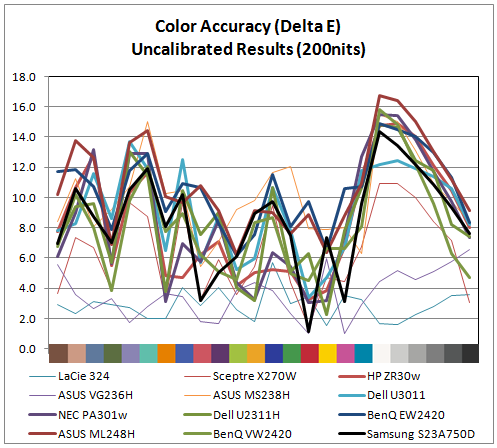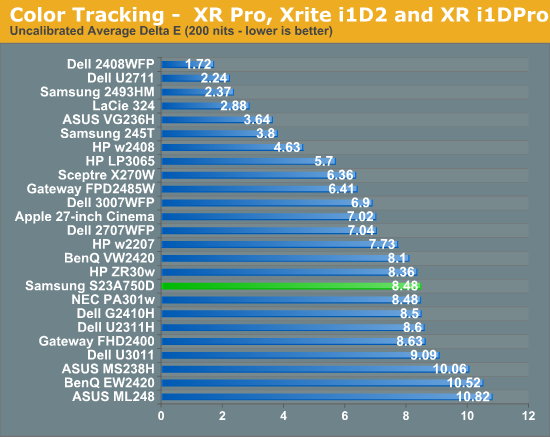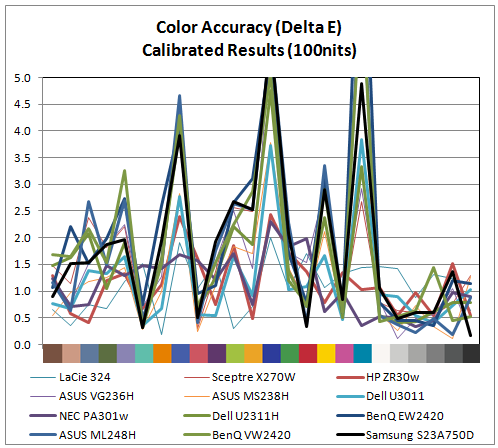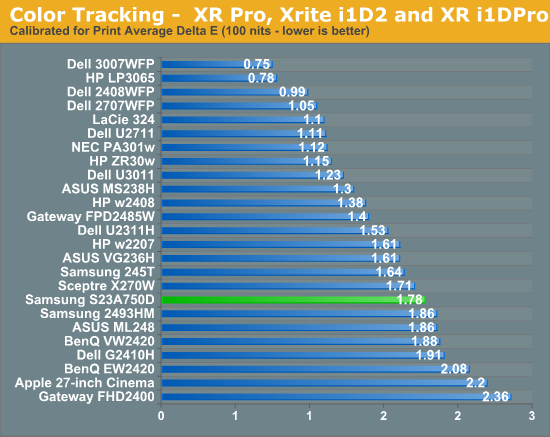Samsung S23A750D 3D LCD Display
by Chris Heinonen on December 17, 2011 2:45 PM ESTSamsung S23A750D Viewing Angles and Color Quality
The Samsung is a TN panel but Samsung advertises improved viewing angles as one feature of the S23A (with the name "Magic Angle Vertical"); you can read about this and additional features on their product page. As you'd expect there's plenty of marketing hyperbole to be found, but in practice I did notice that the S23A has better viewing angles than competing TN solutions.
Most TN panels experience huge color shifts when viewed from the top or bottom of the monitor, and once they get past 20” or so in size you start to see the shift even when attempting to view straight on; by comparison, the S23A looks good when viewed straight on and I didn't see noticeable shifts from my normal viewing area. However, this remains a TN panel and when viewed from accute angles the shift in color and contrast is still present.
Unfortunately, while viewing angles are better than most TN displays, the pre-calibration Delta E numbers are as bad as we've come to expect from consumer displays.


With an average dE over 8 and some of the worst overall numbers occurring the grayscale, the initial numbers for the Samsung aren't very good. The result is similar to competing displays, but still disappointing. Let's move on to calibrated results.
Using the color settings to get the white balance as close as possible to D65 and then setting the brightness and contrast to get 200 nits of light output, I ran the calibration routine in ColorEyes Pro to see if the Samsung could perform any better.


The numbers for the Samsung are overall very good once calibrated. Not only do we get an average dE of 1.77, but the only large errors at all are once again in shades of blue, including the shade of cyan that falls outside of the sRGB spectrum. The entire grayscale spectrum is under 1.0 dE, and only 3 of the 24 swatches are above dE 3, which is the visible level if ColorEyes uses dE76 (which I’d assume, but can’t confirm). Hopefully in the near future we will be able to get all these results in dE94, which is more accurate for measuring color error. I also went ahead and did the same test, though at 100 nits instead of 200 nits, which is what might be used if you are doing print work.


Here the performance is almost identical to the 200 nits data. The grayscale isn’t quite as good, but still virtually perfect, and almost all the issue falls at the same three sample points. Overall the performance here was much better than I expected from a TN panel.















80 Comments
View All Comments
AnnihilatorX - Monday, December 19, 2011 - link
Agreed too.I suppose it's some form of advertising contract with AMD and OCZ acting kind of a sponsor to the site.
Anand Lal Shimpi - Monday, December 19, 2011 - link
We weren't asked to do that by anyone (nor do we allow "advertorial" content on the site - I'll be posting some updated AT guidelines in the not too distant future). From time to time we get updated hardware for our testbeds and we typically call it out in our reviews, the intent here was no different although I do understand that it was interpreted quite differently.Take care,
Anand
Sabresiberian - Monday, December 19, 2011 - link
If you were thrown off by seeing pictures of the PSU, then you weren't reading the article very well. It was obvious to me why Chris might put pictures of the PSU he put in the computer he used to run the video card to run the monitor he was testing. :)I haven't read the whole article, but I suspect some of what is going on here is inflexibility and an inability to read properly. In this day and age, people commonly don't read anything longer than a sentence or two without zoning out.
It's in large part due to a culture in which we have so many distractions (at least in the "western civilized world") that we feel pressed for time, all the time. It's hard to take the time to read an article properly. However, if you are going to read an artivle, I suggest doing it right, and doing it thoroughly, if you really are wasting your time.
;)
Finraziel - Tuesday, December 20, 2011 - link
Agreed, I wasn't bothered by this at all either. The bit about upgrading the GPU and PSU was useful and Chris even specifically states why he included it. It is to stress the fact that if you want to use this monitor for 3D gaming, you are going to need a high power system.About the product, I agree 120hz is very interesting, even more than 3D I think, but it's a shame you have to sacrifice in other areas to get it for now. Hope we soon get 120Hz non-TN panels and some standardisation in 3D gaming.
robinthakur - Monday, December 19, 2011 - link
I found it a tad odd that the person reviewing the display wasn't initially using it with a system which would show it at its best and needed to upgrade their pc on the fly, which could introduce additional bugs.I also take issue with the following bit:
"Since LCD phosphors don’t turn on and off instantly but have a bit of decay time"
This is not a correct explanation of why motion can blur and 3d images can ghost on an LCD screen, more likely a plasma display if we're talking about phosphors and decay-time!
Thanks for the review though, and I'm sure everybody takes time to settle into a role.
Sabresiberian - Monday, December 19, 2011 - link
I think it is informative enough to the people who haven't gone through the procedure, who don't understand what running at 120Hz requires, that the information be included. It's not like he did an in-depth review of the PSU, he just devoted a couple of brief paragraphs with pictures in between.As far as quality - Anandtech has added more editors, and they don't all have the same style as Anand. They shouldn't; they should write in their own style. I suggest you develop a broader mind. I'm not saying there aren't mistakes in grammar and sloppiness, but I do think this "going down hill" business is stating the situation too strongly.
;)
Anand Lal Shimpi - Monday, December 19, 2011 - link
Thanks for your feedback (as well as everyone else in the thread). AMD and OCZ provided the hardware to augment Chris' testbed for the review and I asked him to include his thoughts on the upgrade experience here to hopefully provide more of the end-user side of things. It was a one-time thing that won't be repeated in future reviews, just sort of a stake in the ground indicating a change to the standard display reviews testbed.I do hear you loud and clear though and it's not hard for us to change the way we report changes like that in the future. I've added a section header to the GPU + PSU changes to hopefully explain the intention of that section a bit better.
Take care,
Anand
PubFiction - Monday, December 19, 2011 - link
I agree,My interpretation was that this was a shameless way to slip in a plug for OCZ and AMD. And while that may not be the case it is important to think about how different people will interpret an action.
"Since LCD phosphors don’t turn on and off instantly but have a bit of decay time"
Also this one quote jumped out at me. This is an LCD with LED backligting. It does not have any phosphors because it does not have a fluorescent backlight and on top of that even if it did there would be no fade away. Typically LCD backlights are just ON and the pixels just hold until they switch to a new orientation.
Also I do not get the point in sending a light to non gamer to review a monitor with 120hz gaming and 3D gaming as it's major function.
crimson117 - Monday, December 19, 2011 - link
And then he only tests half life 2 and wow...Sabresiberian - Monday, December 19, 2011 - link
Actually, I thought that Chris presented himself early on as someone who wasn't an "authority", but was putting himself in the role of an average Joe User adopting his setup to a 120Hz monitor for the first time, and describing what the experience was like from that viewpoint. Not everything has to be written like a technical brief presentation or be a class on the electronics of how TN panels work.;)